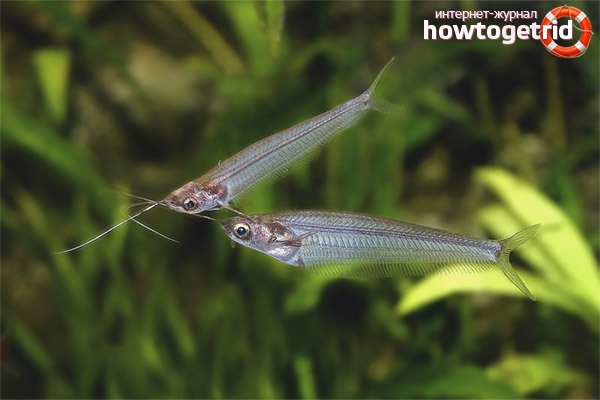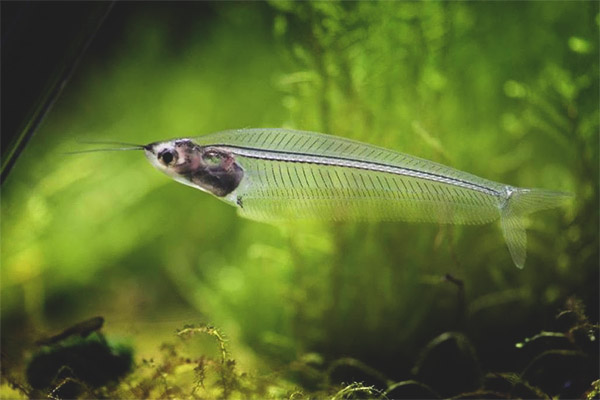The content of the article
A glass Indian catfish in Latin is called Kryptopterus bicirrhis. Because of its original appearance, it is also called the ghost catfish. This fish is very interesting, and many aquarists want to have it in their aquarium. In the wild, there are many species of glass catfish. For the content in the aquarium are used only two of them. This is a glass catfish minor and a glass Indian catfish, which will be discussed. These two species differ in size. The Indian glass catfish grows to about 10 cm, while the minor can reach 25 cm. The main feature of this species is the transparency of the body. This allows you to consider the spine of the fish through. Anyone who sees this catfish for the first time will immediately understand where he got his name from.
The water in the aquarium should be balanced, there should be practically no nitrates in it. By the nature of these fish are shy. Therefore, they can coexist only with very peaceful fish.It is better to keep glass catfish not alone, but in a small flock.
Habitat in nature
In nature, glass catfish lives in rivers that flow into the Gulf of Siam. His homeland is Indonesia and Thailand. Basically, it lives in rivers and streams with a slow current and muddy water. Gathering in flocks, the fish stand with the flow to catch prey.
Description
The glass catfish has a pair of whiskers on the upper lip. They are quite long. At the sight of a fish there is a feeling that it has no dorsal fin. But on closer examination, you can see the process that is immediately behind the catfish's head. They have no fatty fin at all.
Two species that are sold for aquariums are often confused. Fish is sold under the name Kryptopterus Minor. That is a glass catfish minor. But in fact, this species is sold very rarely, as it grows to rather large sizes (25 cm).While the Indian catfish grows only up to 10 cm.
Content issues
Due to the fact that the fish in the content is quite complicated, it is not recommended to acquire inexperienced aquarium lovers. Before buying a glass catfish, you must learn to maintain the aquarium in accordance with the required parameters. If the water parameters change, catfish can get sick and even die. Kind of prone to disease, different shyness. Neighbors can be only very peaceful fish.
Content
The ideal water for a glass Indian catfish is soft, slightly acidified. These are the most sensitive to change fish among all catfish. If you violate any conditions of detention, the fish may lose its transparency. It will become plain opaque. If this situation occurs, it will mean that something is wrong with the aquarium.
These transparent fish prefer warm water. To keep their appearance and not hurt, it is necessary to ensure that the water is always not colder than 26 degrees. Do not allow sudden changes in temperature. Ammonia and nitrates should be as low as possible.Representatives of the species are also very sensitive to these indicators. One can not contain them. In nature, these catfish live in flocks, and therefore in the aquarium they need to be planted from 10 individuals. If there are fewer or you get one fish, it will not live long. For a flock of 10 individuals, it is necessary to prepare at least a two hundred-liter aquarium.
Since in nature these catfish live in rivers with a small flow, it is also desirable for them to create similar conditions in an aquarium. In addition, regular water changes must be performed. And the content of harmful substances should be controlled using a good filter. The pH should be in the range of 6-7. Only by observing all these conditions, you save the health of the fish. They can live up to 8 years.
These fish will spend a lot of time in the algae. Therefore, it is important to provide them with dense thickets in which they pray to hide. Among plants, these timid catfish will feel better. It is also important that they have enough space to swim.
Feeding

Representatives of this species prefer live food.Therefore, it is best to give them a shredder, daphnia, artemia. But you can accustom them to the granulated feed. These should be small granules that will slowly sink to the bottom. The mouth of these fish is very small, so all the food you feed them should be shallow. It is important to remember that in nature they eat fry, so it is impossible for them to be with them in the general aquarium.
Compatibility
Glass catfish is not dangerous for any species of fish, except fry. Therefore, in the general aquarium they can be quite contained.
Glass catfish are prone to various diseases. Therefore, if an individual shows signs of illness, it must be quarantined, where the treatment will be carried out. Sick catfish eat poorly, their body may become clouded, their behavior changes.
Sex differences
To date, experts do not have data on the sex differences of glass catfish.
Breeding
At home, this type of fish is bred very rarely. Fish sold in stores are likely to be caught in nature. Also in some Asian countries there are special farms for their breeding.
Video: glass catfish (Kryptopterus vitreolus)











To send